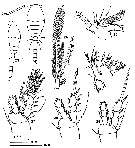|
|
 |
|
Cyclopoida ( Order ) |
|
|
|
Oithonidae ( Family ) |
|
|
|
Oithona ( Genus ) |
|
|
| |
Oithona bowmani Rocha, 1985 (F,M) | |
| | | | | | | Syn.: | Oithona amazonica: Ferrari & Bowman, 1980 (p.5, figs.F, Rem.);
Oithona gessneri : Cipolli & Carvalho, 1973 (part.) | | | | Ref.: | | | Rocha, 1985 (p.217, figs.F,M) |  issued from : F.D. Ferrari & T.E. Bowman in Smiths. Contr. Zool., 1980, 312. [p.7, Fig.2 a-h]. As Oithona amazonica. Female (off mouth of Amazon): a, habitus (lateral right side); b, urosome (lateral (right side); c, caudal ramus (dorsal); d, Md; e, P1; f, P2; g, P3; h, P4. Nota: Prosome/Urosome = 1.3-1.4. Exopodal segments of P1 with 1-1-3 external spines; terminal seta on segment 3 looks like the other 4 internal setae, the lateral membrane is absent and both margins are plumose. External spines of exopodal segmets: P2: 1-1-3; P3: 1-1-1; P4: 0-0-1. Exopodal segmets 3 of P2-4 with terminal setae well developed. Knob near genital opening armed with a minute, slender spine.
|
 issued from : C.E.F. Rocha in Rev. Hydrobiol. trop., 1985, 18 (3). [p.218, Figs.22-29]. Female (from Tocantins River): 22-23, habitus (dorsal and lateral, respectively); 24, caudal ramus; 25, Md (mandibular palp); 26, Mx1; 27, P1; 28, P2; 29, P3. Scale bars = 0.050 mm. Nota: - Ratio Prosome : Urosome: 1.3-1-1.4 : 1 (in 20 specimens) and 1.2-1.3 : 1 (in 10 specimens). - Forehead truncate in dorsal view (fig.22) and rounded laterally (fig.23). - Rostrum absent. - Caudal rami twice longer than wide and little shorter than anal somite; inner apical seta 2.5 times longer than outer apical seta; dorsal seta longer than outer median apical seta; inner median apical seta twice length of outer median apical seta. - A1 with 13 segments, reaching prosome-urosome articulation (when bent backwards). - Md with 5 setae on endopod; basis with 2 spines, the outermost little more than twice longer than the innermost, both armed with spinules. - Mx1 with 3 setae on basis and 2 slender, short setae on endopod. - Number of outer spines of exopod of P1-P4: 1. 1. 3; 1. 1. 3; 1. 1. 1; 0. 0. 1. - P1 with only proximal spine of exopodal segment 3 with hyaline marginal membrane; other outer spines very finely serrate; apical spine seta-like, being finely serrate externally and plumose internally. - Endopodal segment 3 pf P4 with proximal seta the thickest and longest of endopod and with serrate flange on distal 2/3. - Terminal segment of P5 with seta reaching posterior border of genital somite. - Genital somite with a knob near genital opening armed with a minute spine.
|
 issued from : C.E.F. Rocha in Rev. Hydrobiol. trop., 1985, 18 (3). [p.219, Figs.30-37]. Female: 30, P4 (the arrow indicates the modified seta); 31, P5 and genital segment (lateral). Male: 32, habitus (lateral); 33, pore signature of the cephalosome flap; 34, caudal rami; 35, Md (mandibular palp); 36, exopod of P1; 37, partial and lateral views of the urosome bearing P5 and P6. Scale bars = 0.050 mm. Nota Male: - Cephalosome protruded laterally into a flap extending beyond posterior border of thoracic segment 1. Pore signature of flap as in fig.33 (in 4 specimens). - Caudal rami about 1.5 times longer than wide and with armature as in fig.34. - Md with 5 setae on endopod. - Exopod of P1 with 3 marginal spines as in female. - All setae of P1-P4 plumose. - P5 and P6 as in fig.37.
| | | | | NZ: | 1 | | |
|
Distribution map of Oithona bowmani by geographical zones
|
| | | | Loc: | | | Brazil (Xingu, Maratapa Bay, Acara Grande River, Tucurui) | | | | N: | 3 | | | | Lg.: | | | (870) F: 0,56-0,62; 0,65-0,7; M: 0,58-0,62; 0,64-0,66; { F: 0,56-0,70; M: 0,58-0,66} | | | | Rem.: | brackish.
This species closely resembles Oithona amazonica. The main difference is the number of external spines of exopodite 3 of P1 of the females. Males of both species are very similar, but can be separated by the length of the setae on the caudal rami, presence of a double, curved row of pores between 4th and 5th column in the cephalosomic flap and by the length of the setae of endopod of Mx1.
After Rocha (1985, p.219), this species has been found from the mouth of Acarà (Grande River) as far as Tucurui (Tocantins River); its occurred together with O. bjornbergae. It seems to inhabit preferably without tidal influence; temperature range 27.0°-32.6°C, pH range: 6.0-7.0. | | | Last update : 12/12/2017 | |
|
|
 Any use of this site for a publication will be mentioned with the following reference : Any use of this site for a publication will be mentioned with the following reference :
Razouls C., Desreumaux N., Kouwenberg J. and de Bovée F., 2005-2025. - Biodiversity of Marine Planktonic Copepods (morphology, geographical distribution and biological data). Sorbonne University, CNRS. Available at http://copepodes.obs-banyuls.fr/en [Accessed August 27, 2025] © copyright 2005-2025 Sorbonne University, CNRS
|
|
 |
 |






